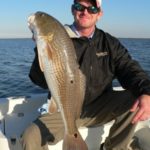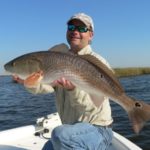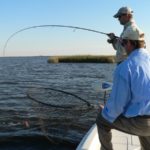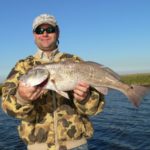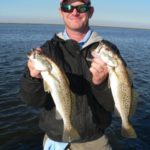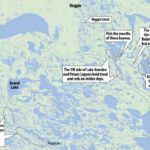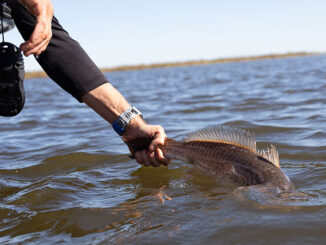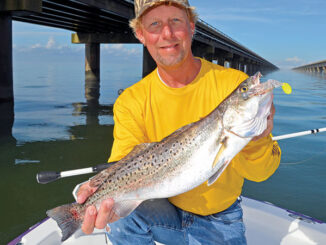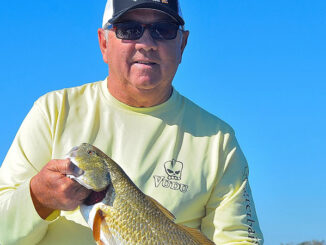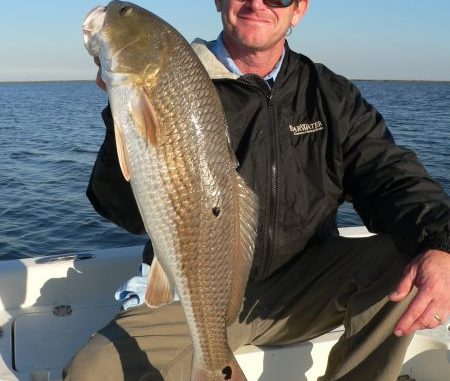
Wintertime in Reggio means plenty of reds and trout — with black drum, flounder and sheepshead, as well. And you usually don’t have to make long runs. Here’s how these captains keep their customers happy.
According to Merriam-Webster, a “roundup” is a gathering together of people or animals or items. As in a cattle roundup, or a police roundup of suspects.
In January, as the weather and water temperatures drop and water levels fall along with them, Reggio is a great place to launch to do your own winter roundup.
Reds are on the prowl in both deep and shallow water, and trout can be gathered in piles or scattered across flats and shallows, depending on the weather.
Add black drum, sheepshead and flounder to the mix and you can round up a very nice box of fish — even in January.
For some reason I always think of Reggio when winter weather rolls in. That’s probably because I remember so many great cold-weather trips I’ve had out of there over the years.
But it’s also a great launch site the rest of the year. Many anglers reported great catches all through the fall, and no one had to run very far to find good fish.
Reggio Marina manager Mike Turgeau said he often caught his limits of both reds and specks this fall fishing right along the Reggio Canal from the bank of the marina. It doesn’t get much easier than that.
The spring also is productive as winter transitions into milder temperatures, and trout and reds linger until summer arrives. Then, like everywhere else, a long run to the coast becomes necessary to find fish.
But for now, this is as far as you have to go to get in on some great trout and redfish action, with a bonus of black drum, sheepshead and flounder as side dishes.
I called Captain Darren Schaff (504-400-2466) to see if I could persuade him once again to take me along on a Reggio excursion, and we put a date on the calendar.
Which due to inclement weather, we postponed. And then postponed again.
That’s just something you learn to accept in this game: The weather does all the dictating, no matter what month you’re trying to fish.
Finally we got a fair-weather window, and I met Schaff at his camp on the edge of the Reggio Canal. Conditions were such that we opted for an afternoon trip, which tends to make for shorter trips this time of year since it gets dark at 5:30 p.m.
But I did like the idea of some afternoon sunshine and warmth that makes for a much more comfortable trip. Besides, the afternoon sun warms up the chilly water and makes the winter fish more aggressive.
On such days you can even fish ander corks and in shallow water, just like in fall and spring.
Schaff was waiting at the dock, along with his long-time friend and partner in crime Capt. Danny Craven. Besides running a busy construction business, Craven also runs guided trips along with Schaff.
I figured I’d hit the jackpot. Not one but two charter captains to guide me to the fish.
Another advantage of an afternoon departure is that we were able to leave the heavier bulky coats behind and wear lighter jackets. I knew we’d be good as long as we returned before dark, when the evening chill would set in.
“Where and how I fish in January is determined by the weather,” Schaff said. “If its cold, naturally I’ll fish deeper water, mostly in the bends of the bayous.
“And I keep it simple. I use only a few different plastics. I like the H&H cocohoes in black/chartreuse, purple/white and red ice or the Matrix Shads in lemonhead or shrimp creole.”
How he worked these lures depends on the conditions, so he could be tight-lining, working them with a slow cast-and-retrieve or fishing them under corks.
“I like the lemonhead color in most conditions except in very clear water; then I prefer the shrimp creole color,” Schaff said of the Matrix Shads. “Live bait is no longer necessary, which is a great cost savings, and its just so much easier not having to continually replace a live shrimp on your hook.”
As for line, Schaff said he likes braid and monofilament.
“Mono is just so easy to use. It’s forgiving, it doesn’t knot up like braid and even amateurs can fish with it easily,” he explained. “But I like the strength and sensitivity of braid, especially in the winter, when you fish by feeling rather than sight. You want to be able to feel your bait bouncing on the bottom, and the no-stretch sensitivity enables you to do that.
“The cold-water bite of a speckled trout can be very subtle, and that plus its strength is where braid excels.”
But Schaff said he hates the aggravations you can’t escape when he takes customers out and all his rods are strung with braided line.
“Wind knots and tip wraps that lead to tangles are what I hate about braid. You just can’t untangle it,” he said. “So I spend too much time dealing with that rather than helping them catch fish.
“So, I love braid, and I hate it. Depending on the day.”
Schaff said his favorite cold-weather hunting ground is Bayou Robin and Bayou Batola.
“That’s as far as I generally have to run to find fish,” he said. “On the colder days I set up the boat so I can fish the turns or the mouths of those bayous, and I fish the same plastic baits on the bottom, with either a ¼- or 3/8-ounce jig, depending on the current and the depth of the water.
“In deeper water with more current, I’ll use the heavier jig, but in most situations I’ll use a ¼-ounce jig.”
Only when he has no choice will he run past these two honey holes.
“On those rare days when the weather is cold and the water is cold and I just can’t get a bite going, I’ll bite the bullet and make the haul over to Oak River,” Schaff said. “I particularly like to fish the section between Spanish Lake and Skippy Lake, where I’ll anchor and fish around the various intersections, tight-line, bouncing my bait along the bottom using single and sometimes double jigs.
“I dread having to make that run because it’s a good distance and because of the boat traffic in Oak River, but when in a pinch, you gotta do what you gotta do.”
Fortunately, a long trip wasn’t on the menu on this sunny afternoon — Schaff said he and Craven were on a good bite in shallower water much closer to the dock.
For two days before our trip, stiff easterly winds made for extremely difficult conditions, but easterlies pushed the tide up significantly. That opened up some fishing possibilities not always available this time of year — and Schaff intended to take advantage of it.
We ran the Reggio Canal into Lake Amedee and then across it into Petain Lagoon, where the guides left the fish biting on their last trip.
“On a colder day when the tides are low, this would not be our tactic,” Schaff said. “We’d stay in deeper water and fish the bayous on the bottom.
“But today it’s very mild and sunny, and the fish will be up feeding over the flats in shallower water, so that’s where we’ll fish.”
He motored the boat slowly toward a prominent point on the south end of Petain and lowered the Power-Pole when we were near enough to reach the point with a long cast.
But the point actually wasn’t our target — the open water around it was.
The three of us fished in all directions to see if the fish were where they left them a few days before. This was shallow water, probably not more than 3 feet deep, so we all fished under popping corks.
Within minutes we started getting some good bites.
I was fishing a natural-colored Vudu shrimp and got hits consistently. The two captains were tossing a variety of plastics, and we even had some live shrimp Schaff had scrounged up.
Everything worked.
The bite wasn’t fast and furious, but everything we tossed produced fish. It was one of those rare days when there were simply no bad baits.
Craven said another worthwhile area to fish under these milder, high water conditions is the southwest side of Lake Amedee.
“All the broken-up, shallow marshes, the small grass islands and flats can all be pretty productive,” he said. “You can troll off the points and around the small islands, and cast spoons and spinnerbaits for reds. And you can also stick your Cajun anchor at a good point and fish with plastics under a cork.
“If you don’t get any action along the shorelines, then move out from the bank about 75 to 100 yards and just drift fish for trout, using plastics under a cork. Tandem-rigged beetles are good baits for drift fishing”
The approach changes when the shallow areas get too skinny.
“(W)hen the water is lower and the winds are blowing, then you want to fish deeper,” Schaff said. “Another favorite area is the north side of Lake Robin, where all the bayous come in. Usually our winds are out of the north this time of year. so that will be the lee side — and we do good in that area for both trout and reds.
“And you can follow that tactic in any of the bays and lakes. Fish along the lee side at the mouths of cuts and bayous, and try both cast-and-retreive and under corks. You have to hunt for them, but if you keep looking they’ll turn up.”
Schaff said we usually get some milder days — even in January — and when we get a few of those warmer days in a row you can fish in shallower water under corks at quite a number of spots in Delacroix.
“Besides Lake Amedee and Lake Robin, Four Horse Lake is another of my favorites, and also Pato Cabello,” Schaff said. “Fish around the mouths of the various cuts and bayous, both under corks and on the bottom, drifting until you bump into some action, or stick off points and fan-cast to work the area more thoroughly.
“All those areas hold fish, and on sunny afternoons like this one they are definitely worth trying.”
Meanwhile, we’d loaded our ice chest with some very respectable trout, and only had to move a couple times to do so.
Our first stop produced a number of nice fishm but the action stopped as quickly as it started. Schaff moved us to another point and we pulled both reds and specks over the gunnel until we nearly ran out of daylight.
You gotta love these warm, sunny afternoon trips, especially in January.
Captain Darren Schaff can be reached at 504-400-2466.
